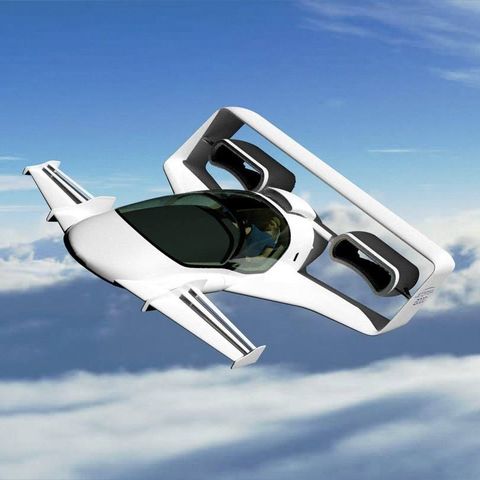The U.S. Air Force is preparing to unveil 35 new aircraft designs that could revolutionize personal flight. Over the last few months, the service received 218 submissions for a new High-Speed Vertical Takeoff and Landing (HSVTOL) aircraft, and may place one or more winners into production. The goal is to create a new class of small, Jeep-like aircraft not tied to airfield runways that can support operations in austere—think really, really basic—environments.
HSVTOL is meant to develop a new generation of aircraft designed to take advantage of new technologies, particularly electricity-powered airplanes. The planes are meant to carry between one to 12 people, and typically use rotating propellers, ducted fans, and other technology to take off like a helicopter and fly like an airplane.
Typically, this involves rotating the engine nacelles 90 degrees while the aircraft is in midair, from a downward-thrust position to a forward-thrust position. This technology, pioneered in service by the V-22 Osprey tiltrotor, has an advantage in that the aircraft only needs one set of engines for vertical and horizontal flight.
AFWERX, a program of the Air Force meant to create a startup-like culture within the service, initially announced the HSVTOL Concept Challenge in 2017. In May, the program put out a call for submissions, which remained open for a little over one month. In August, the program held a showcase to debut some of the most promising solutions, as New Atlas first reported.
“You might one day get your flying car after all, courtesy of the U.S. Air Force.”
But which kind of craft is going to win? Think of it this way: the Air Force is essentially looking for a 21st-century Jeep. In the months before World War II, the Willys-Overland company developed a small, four-person, cross-country vehicle. The Jeep was compact enough to carry in gliders, could ford rivers with ease, and was extremely reliable. The U.S. military purchased 637,000 of them for itself and for allies, using them for everything from stretcher carriers to anti-tank vehicles, from battlefield reconnaissance to driving around VIPs. By the late 1950s, the U.S. Army had even deployed a Jeep with a nuclear weapon, making the lowly vehicle one of the most powerful weapons of all time.
That’s basically what the Air Force wants, except now it believes new technologies are mature enough that it can get a 21st-century, flying version of the Jeep. The service wants HSVTOL aircraft that can autonomously pick up downed fliers behind enemy lines; shuttle maintainers and personnel from large, sprawling air bases to small, austere ones; and deliver munitions, spare parts, and equipment when needed. In wartime, air power will need to disperse and hide to survive enemy aircraft and missile attack. Many flying Jeeps shuttling supplies to remote, austere bases will be better at avoiding detection than a lumbering, easily detected C-130 Hercules.
One of the 35 designs advancing in the competition is the Jetoptera J-2000. It’s a one- or two-person aircraft with a payload of 450 to 800 pounds, a top speed of 200 miles per hour, and a range of 200 miles. The J-4000, meanwhile, is a larger aircraft that can carry four people.
Jetoptera’s aircraft utilize a unique fluidic propulsion system, in which a turbine powers a turbo compressor. The compressor expels the fluidic air and creates a vortex that in turn sucks in and pushes out ambient air, generating thrust. Jetoptera claims its holistic approach—designing both the engine and the aircraft to complement one another— increases propulsive efficiency while lowering fuel consumption and overall weight.
Another aircraft design that made the cut is the FusionFlight JetQuad. The JetQuad’s propulsion system works in much the same way as the Marine Corps’ AV-8B Harrier II. The JetQuad is powered by four microturbine engines, each routing thrust through a separate, rotating exhaust nozzle. The four nozzles can then rotate to support vertical takeoff and level flight. (The Harrier was powered by a single Rolls-Royce Pegasus engine, routing the thrust to four nozzles.)
The JetQuad is currently a technology demonstrator, and the company has plans to scale it up to create a medevac drone capable of carrying a single injured passenger to a field hospital. Another larger design is a vertical takeoff and landing aircraft capable of carrying two persons.
The Barracuda is slightly larger than a U.S. Army UH-60 Blackhawk helicopter, with room for 14 and a maximum payload of 12,500 pounds. Advanced Tactics believes the aircraft will be able to cruise at 400 knots. In vertical mode, the aircraft should have a range of 2,400 nautical miles, while in airplane mode, the company anticipates a range of 3,200 miles.
The 21st-century flying Jeep is probably an idea whose time has come. The combination of tiltrotor technology, microturbines, and computer-assisted flight controls could very well combine to create a small utility vehicle not only for the Air Force, but the other services as well. The technology would inevitably trickle out to the private sector and commercial, even personal, aviation. Heck, you might one day get your flying car after all, courtesy of the U.S. Air Force.
Source: Read Full Article


